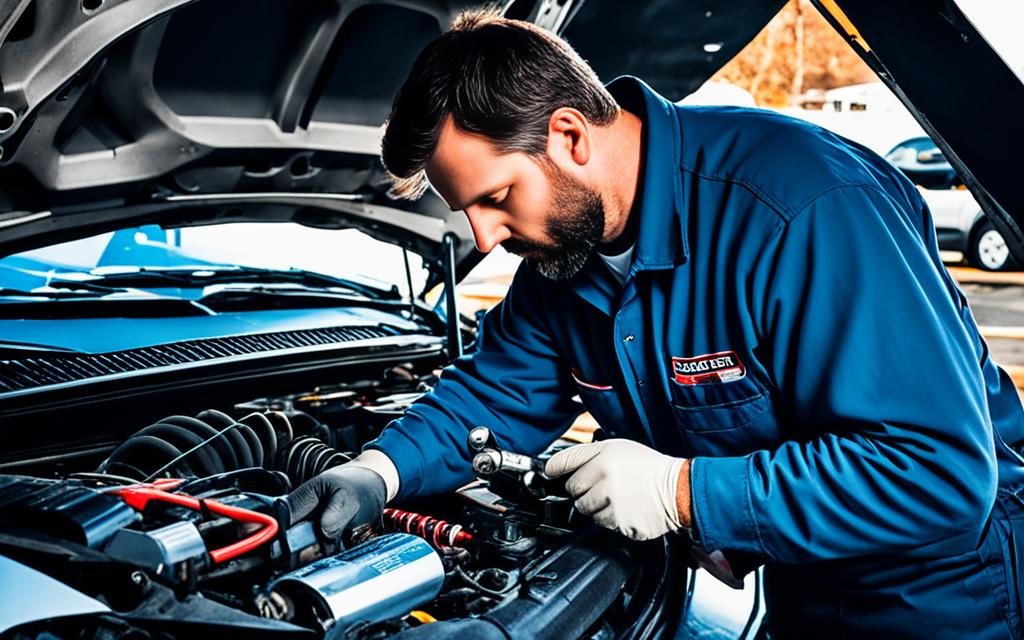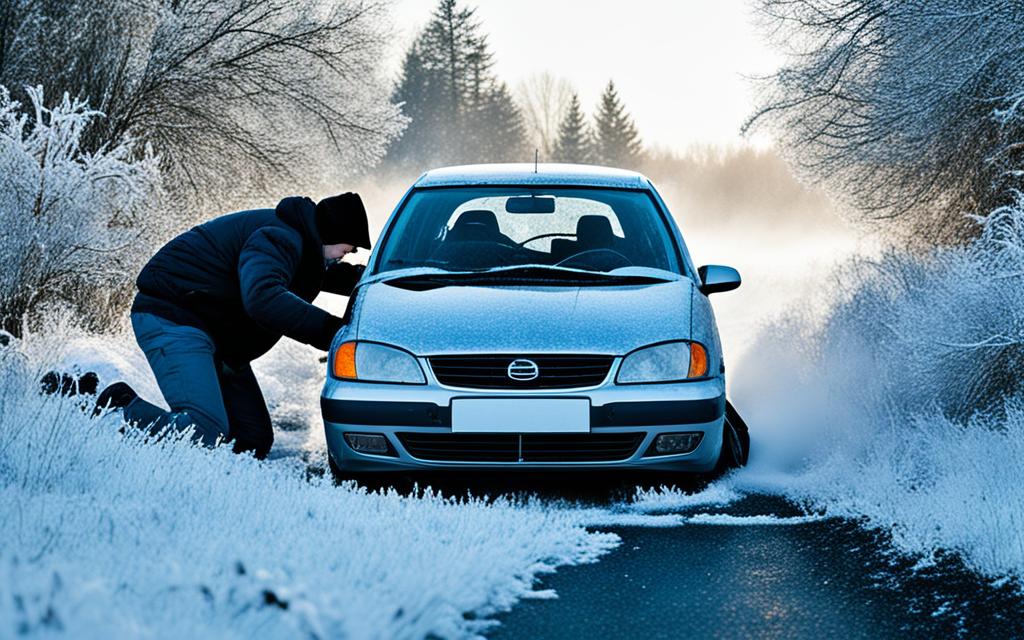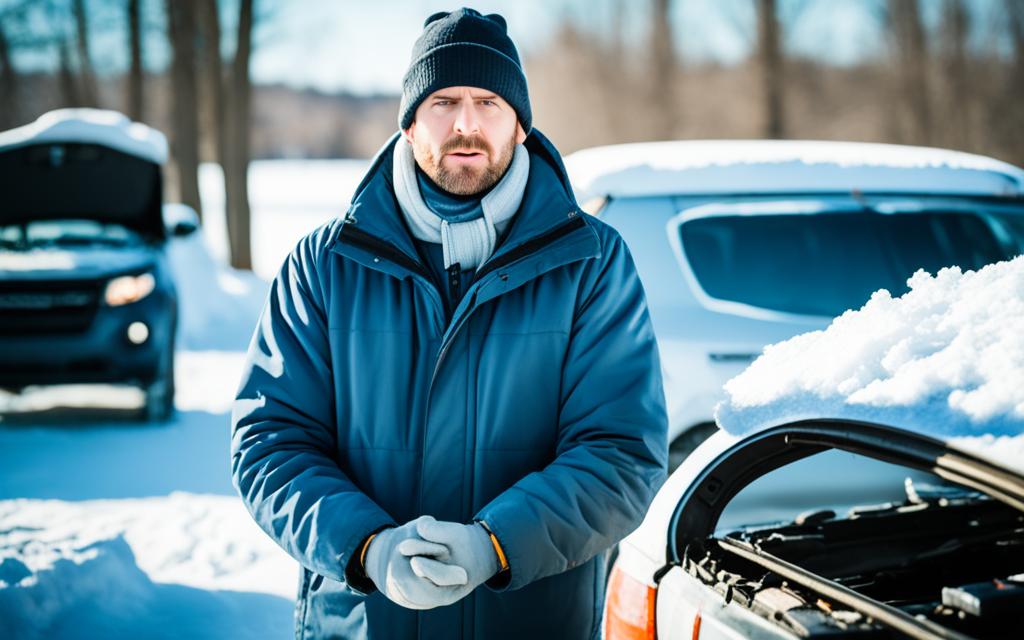Are you experiencing the frustrating problem of your car not starting in cold weather, even when the battery is in good condition? Well, you’re not alone. Cold weather can pose unique challenges for vehicles, causing starting issues that can leave us feeling stranded. But fear not, because we’re here to help you troubleshoot and fix the problem so you can get back on the road in no time.
In this comprehensive guide, we’ll delve into the reasons behind your car’s reluctance to start in cold temperatures, despite having a good battery. We’ll explore the various components of your vehicle that may be affected by the cold, such as the fuel system, ignition system, starter motor, and more. By understanding these potential issues, you’ll be equipped to diagnose and resolve the problem yourself, saving time and money on unnecessary repairs.
Key Takeaways:
- Car not starting in cold weather is a common problem, even with a good battery.
- The cold can affect various components of the vehicle, causing starting issues.
- Key areas to check include the battery, fuel system, ignition system, starter motor, engine coolant, and engine oil.
- Other factors like temperature sensors, weak alternators, and electrical issues can also contribute to starting problems in the cold.
- Regular maintenance and winterizing your vehicle can help prevent cold weather starting issues.
Understanding Cold Weather Starting Problems
Starting your car in cold weather can be a frustrating experience, especially when it refuses to start. Cold temperatures can present specific challenges that affect various components of your vehicle, leading to starting problems.
When the mercury drops, your car’s battery can struggle to provide enough power to start the engine. The cold weather can cause the battery to discharge more quickly, reducing its cranking power. Additionally, low temperatures can thicken the engine oil, making it harder for the engine to turn over.
The fuel system can also be affected by cold weather. Fuel can become thicker and lose its volatility, making it difficult for the engine to ignite properly. Cold temperatures can also cause fuel lines and injectors to freeze, further hindering the starting process.
The ignition system, including the spark plugs and ignition coils, may also struggle in cold temperatures. Cold weather can impair the spark plugs’ ability to generate a strong spark, leading to misfires or no ignition at all.
Furthermore, the starter motor, solenoid, and related wiring could be affected by the cold. These components may experience increased resistance, resulting in reduced power delivery and difficulty in cranking the engine.
To get a better understanding of the challenges posed by cold weather on car starting, let’s take a closer look at each component affected by low temperatures:
- Battery
- Fuel System
- Ignition System
- Starter Motor
Now that we understand the cold weather starting problems, let’s explore how to address each component to improve cold weather starting performance.
Checking the Battery
One of the main culprits for a car not starting in cold weather, even with a good battery, is a battery that is not functioning properly. It’s important to examine the battery to ensure it can deliver enough power to start the engine in cold temperatures. Follow our step-by-step instructions below to test the battery and diagnose any potential issues.
Step 1: Visual Inspection
Start by visually inspecting the battery for any signs of damage, such as cracks or corrosion. If you notice any damage, it may indicate that the battery needs to be replaced.
Step 2: Checking Battery Voltage
Tip: Before performing any tests, make sure the engine is turned off and the car’s lights and accessories are all switched off.
- Use a multimeter to measure the battery voltage. Set the multimeter to the DC volts setting.
- Connect the multimeter’s positive (red) probe to the battery’s positive terminal (+) and the negative (black) probe to the battery’s negative terminal (-).
- Read the voltage displayed on the multimeter. A fully charged battery should have a voltage reading of around 12.6 volts. If the voltage is significantly lower, it may indicate a weak or discharged battery.
Step 3: Load Testing the Battery
A load test can help determine if the battery is capable of delivering enough power to start the engine in cold weather. Follow these steps to perform a load test:
- Disconnect the battery cables, starting with the negative cable (-).
- Connect a battery load tester to the battery according to the manufacturer’s instructions.
- Activate the load test and monitor the results. The load tester will apply a simulated load to the battery to assess its capacity. A healthy battery should be able to maintain a voltage above 9.6 volts during the test.
- If the battery fails the load test, it may need to be replaced.
Step 4: Diagnosing Battery Issues
If you find that your battery is not functioning properly, there are a few potential issues that could be causing the problem:
- The battery terminals may be corroded or loose. Clean the terminals and ensure they are securely tightened.
- The battery may be discharged due to extended periods of inactivity or a parasitic drain. Consider charging the battery using a battery charger or jump-starting the vehicle. If the battery continues to discharge, there may be a parasitic drain that requires further investigation.
- The battery may have reached the end of its lifespan. Most car batteries last around 3-5 years and may need to be replaced.
By thoroughly checking your battery and addressing any issues, you can improve the chances of your car starting reliably in cold weather, even with a good battery.
Evaluating the Fuel System
When your car won’t start in cold weather after sitting overnight, one of the potential culprits could be your fuel system. The fuel pump, filter, and injectors play a crucial role in delivering the right amount of fuel to the engine, ensuring a smooth start even in chilly temperatures.
To diagnose and resolve fuel-related problems, it’s important to thoroughly examine each component of the fuel system. Here’s a step-by-step guide to help you evaluate and troubleshoot:
1. Fuel Pump
The fuel pump is responsible for transferring fuel from the tank to the engine. A faulty fuel pump can result in insufficient fuel delivery, leading to starting difficulties in cold weather. Check for signs of a failing fuel pump, such as sputtering engine or difficulty starting, and consider having it inspected or replaced if necessary.
2. Fuel Filter
The fuel filter ensures that the fuel entering the engine is clean and free of contaminants. Over time, the filter can become clogged, restricting fuel flow and causing starting issues. Regularly inspect the fuel filter and replace it if it appears dirty or clogged.
3. Fuel Injectors
Fuel injectors spray the fuel into the engine cylinders, allowing for efficient combustion. Dirty or clogged injectors can disrupt this process and lead to poor starting performance, particularly in cold weather. Consider using a fuel injector cleaner or consult a professional for a thorough cleaning if needed.
By carefully evaluating and addressing any fuel system problems, you can improve cold weather starting reliability. Remember to consult your vehicle’s manual or seek professional assistance if you are unsure of any components or procedures.
In addition, proper fuel maintenance, such as using quality fuel and keeping the tank above a quarter full during colder months, can also help prevent starting issues in the first place.
“A well-maintained fuel system is essential for reliable cold weather starts.”
| Fuel System Component | Common Issues | Resolution |
|---|---|---|
| Fuel Pump | Sputtering engine, difficulty starting | Inspect and replace if necessary |
| Fuel Filter | Dirty or clogged filter | Regularly inspect and replace if needed |
| Fuel Injectors | Dirty or clogged injectors | Use fuel injector cleaner or consult professional for cleaning |
By addressing fuel system issues and following proper maintenance practices, you can ensure that your car starts reliably even in the coldest weather conditions.
Checking the Ignition System
When troubleshooting car starting problems in cold weather, it’s crucial to examine the ignition system components. Cold temperatures can impact the performance of key ignition system elements, such as the spark plugs, ignition coils, and distributor.
The spark plugs play a vital role in generating the spark that ignites the fuel-air mixture in the engine cylinders. In cold weather, worn or fouled spark plugs can struggle to produce a strong spark, leading to starting issues. Inspect the spark plugs carefully, looking for signs of wear, damage, or carbon deposits. If necessary, replace them with new ones optimized for cold weather ignition.
Expert Tip: Consider using spark plugs with a lower heat range for improved performance in cold weather.
In addition to the spark plugs, check the ignition coils and distributor for any signs of wear or malfunction. Faulty ignition coils can result in weak or erratic sparks, making it difficult for the engine to start in cold weather. Similarly, a worn or damaged distributor can cause timing issues, impacting the overall ignition system performance.
If you notice any problems with these ignition system components, it’s essential to address them promptly. Ignition system repairs or replacements may be necessary to ensure reliable starting in cold weather conditions.
Common Ignition System Problems
Here are some common ignition system problems that can contribute to difficulties starting your car in cold weather:
- Weak or worn-out spark plugs
- Malfunctioning ignition coils
- Worn-out distributor cap and rotor
- Corroded or loose electrical connections
Identifying and resolving these issues can significantly improve your car’s starting performance, especially in cold weather.
How to Address Ignition System Problems
If you encounter ignition system problems that affect cold weather starting, follow these steps to address them:
- Inspect and clean the spark plugs or replace them if necessary.
- Test the ignition coils using a multimeter and replace any faulty ones.
- Examine the distributor cap and rotor for wear or damage, replacing them if needed.
- Ensure all electrical connections are secure and free of corrosion.
By addressing these issues, you can significantly improve your car’s ignition system performance in cold weather.

Assessing the Starter Motor
When your car won’t start in the cold but the battery is in good condition, the starter motor may be the culprit. The starter motor is responsible for cranking the engine and initiating the combustion process. If it is not operating effectively or providing sufficient power, your car may struggle to start in cold weather.
To determine whether the starter motor is causing the starting issue, you will need to inspect it, along with the solenoid and related wiring. Here are the steps to help you troubleshoot and resolve starter motor issues:
- Start by visually inspecting the starter motor and solenoid for any signs of damage or corrosion. Check the wiring connections for tightness and ensure there are no loose or frayed wires.
- If everything looks visually fine, you can perform a voltage test to ensure the starter motor is receiving sufficient power. Use a multimeter to measure the voltage at the starter motor terminals while attempting to start the car. If the voltage is significantly lower than the recommended value, it indicates an issue with the electrical supply to the starter motor.
- In some cases, the starter motor itself may be faulty and need replacement. If all other components and wiring are in good condition but the starter motor still fails to provide adequate cranking power, it’s advisable to consult a professional mechanic for further diagnosis and potential replacement.
“Inspecting and troubleshooting the starter motor is a crucial step in resolving car starting issues in cold weather. It ensures that the engine receives the necessary power to kickstart the combustion process. By following these steps, you can diagnose and resolve starter motor problems, enabling your car to start reliably in even the coldest temperatures.”
By assessing the starter motor and addressing any issues, you can improve the cold weather starting performance of your car. Remember, if you’re unsure or uncomfortable performing the inspection and troubleshooting yourself, it’s always best to seek assistance from a qualified automotive professional.
Common Symptoms of Starter Motor Issues
Before diving into the troubleshooting process, it’s helpful to be aware of common symptoms indicating potential starter motor problems. If you experience any of the following issues, there is a high probability of a starter motor-related problem:
- The engine cranks very slowly or doesn’t crank at all.
- You hear a clicking sound when turning the key to start the car.
- The starter motor engages but fails to spin the engine.
- Your car intermittently starts, especially in colder temperatures.
Keep these symptoms in mind as you assess the starter motor, as they can help confirm whether further inspection and troubleshooting are necessary.
Checking the Engine Coolant
One crucial factor to consider when troubleshooting car starting issues in cold weather is the engine coolant. The engine coolant plays a vital role in maintaining the proper operating temperature of your vehicle, especially during freezing temperatures. It ensures that the engine doesn’t overheat in warm weather and, in cold weather, protects against freezing.
To address cold weather starting problems, it’s important to verify that the engine coolant is at the correct levels and is mixed properly to withstand freezing temperatures. Inadequate coolant can have a significant impact on cold weather starting performance, as it can lead to a frozen engine or insufficient heat in the combustion chamber.
Start by checking the coolant level in the overflow or expansion tank. This tank is typically transparent and has markings indicating the minimum and maximum levels. Use caution when opening the radiator cap, as it can be pressurized and cause hot coolant to spray. Ensure the engine is cool before attempting to open the cap.
If the coolant level is low, top it up with a mixture of coolant and water, following the manufacturer’s recommendations. It’s crucial to use the correct coolant type specified for your vehicle. Refer to your owner’s manual or consult a professional mechanic for guidance.
Additionally, ensure that the coolant mix is appropriate for the prevailing temperatures. Coolant mixed with too much water can freeze and cause starting issues. A proper mix, often referred to as a 50/50 mix or antifreeze-to-water ratio, will provide optimal protection against freezing while maintaining sufficient heat transfer properties.
In situations where the coolant mix is incorrect or the coolant is heavily diluted, a coolant flush may be necessary. This involves draining the old coolant and replacing it with the appropriate mixture. Again, it’s recommended to consult a professional mechanic to perform this procedure or seek guidance specific to your vehicle.
By checking and maintaining the engine coolant at the proper levels and mixture, you can minimize the chances of encountering starting problems in cold weather.

| Common Coolant Issues | Potential Consequences | Solutions |
|---|---|---|
| Low coolant level | Overheating, improper heat transfer, frozen engine | Top up coolant to the correct level |
| Inadequate mixture (too much water) | Freezing of the coolant, insufficient heat transfer | Adjust coolant mixture to the appropriate ratio |
| Incorrect coolant type | Compatibility issues, reduced effectiveness | Use the recommended coolant type for your vehicle |
Examining the Engine Oil
One often overlooked factor that can contribute to car starting problems in cold weather is the engine oil. It’s important to evaluate the engine oil to ensure it is the correct viscosity for cold temperatures and is providing adequate lubrication. Incorrect oil viscosity can have a significant impact on starting performance and overall engine health.
The first step in examining the engine oil is to check the viscosity rating. This rating indicates the oil’s flow characteristics at different temperatures. In cold weather, you need oil with a lower viscosity – often referred to as “winter-weight” oil – to ensure proper lubrication during startup.
If the engine oil is too thick, it will struggle to flow efficiently in cold temperatures, leading to increased friction and difficulty in starting the engine. On the other hand, if the oil is too thin, it may not provide sufficient lubrication, leading to premature engine wear and potential damage.
To resolve oil-related starting issues, follow these steps:
- Refer to your vehicle’s owner’s manual to determine the recommended oil viscosity for cold weather.
- Check the current oil viscosity using a dipstick. If the oil appears thicker than recommended or is not the correct viscosity, it may be necessary to drain and replace it with the proper oil.
- When changing the oil, ensure you use a high-quality oil that meets the manufacturer’s specifications for your vehicle. Look for oil labeled for use in cold weather conditions.
- Follow the recommended oil change interval to maintain optimal lubrication and prevent starting problems caused by degraded oil.
Taking care of your engine oil ensures that it can effectively protect your engine during cold weather starts. By regularly evaluating the oil’s viscosity and using the appropriate oil for cold temperatures, you can minimize starting issues and promote a longer engine life.
Ensuring your car’s engine oil is the correct viscosity for cold weather is essential for reliable cold weather starting. By understanding the impact of incorrect oil viscosity and following the necessary steps to resolve oil-related issues, you can improve your car’s starting performance in cold temperatures.
Addressing Other Factors
While a weak battery, fuel system issues, and ignition problems are common culprits behind cars not starting in cold weather, there are other factors that can contribute to this frustrating issue. It’s important to explore these additional possibilities and learn how to identify and resolve them effectively.
Faulty Temperature Sensor
One potential cause of cold weather starting issues is a malfunctioning temperature sensor. This sensor is responsible for providing the engine control unit (ECU) with accurate temperature readings, which in turn affects fuel delivery and ignition timing. If the sensor is faulty, it may inaccurately report the engine temperature, leading to difficulties in starting the car.
To troubleshoot a faulty temperature sensor, consult your vehicle’s manual to locate the sensor and check for any visible signs of damage or corrosion. If necessary, use a multimeter to measure the resistance across the sensor terminals and compare it to the specifications provided by the manufacturer. If the readings are outside the recommended range, it may indicate a faulty sensor that needs to be replaced.
Weak Alternator
Another possible cause of cold weather starting issues is a weak alternator. The alternator is responsible for charging the battery while the engine is running, and if it’s not functioning properly, the battery may not have enough power to start the car, especially in cold temperatures.
To test the alternator, start the engine and use a voltmeter to measure the voltage across the battery terminals. A healthy alternator should produce a voltage reading between 13.8 and 14.7 volts. If the reading is significantly lower or higher, it may indicate a faulty alternator that needs to be repaired or replaced.
Electrical Issues
Electrical problems can also contribute to car starting issues in cold weather. Loose connections, damaged wiring, or a faulty ignition switch can disrupt the flow of electrical current, preventing the car from starting properly.
Inspect the electrical connections, wires, and components in the starting circuit for any signs of damage, corrosion, or loose connections. If you identify any issues, repair or replace the affected parts accordingly. It’s recommended to consult a professional if you’re unsure about handling electrical repairs.
By exploring these additional factors and finding effective solutions for them, you can increase the chances of successfully starting your car in cold weather conditions.
| Factor | Effect | Solution |
|---|---|---|
| Weak Battery | Inadequate power for starting | Recharge or replace the battery |
| Fuel System Issues | Insufficient fuel delivery | Clean or replace fuel pump, filter, or injectors |
| Ignition Problems | Inconsistent spark or timing | Inspect and replace spark plugs, ignition coils, or distributor |
| Faulty Temperature Sensor | Erroneous temperature readings | Test and replace the temperature sensor if necessary |
| Weak Alternator | Inadequate battery charging | Test and repair or replace the alternator |
| Electrical Issues | Disrupted electrical flow | Inspect and repair or replace damaged connections or wiring |
Preparing Your Car for Winter
In order to fix car not starting in cold weather and overcome cold weather car starting problems, it’s important to take proactive steps to prepare your vehicle for the winter season. By implementing the following tips and recommendations, you can minimize starting problems and ensure a smooth start even in the coldest temperatures.
1. Install a Block Heater
Consider installing a block heater, especially if you live in an area with extremely low temperatures. A block heater warms up the engine’s coolant, making it easier for your car to start in cold weather.
2. Use a Winter-Grade Engine Oil
Switch to a winter-grade engine oil with a lower viscosity to ensure proper lubrication in colder temperatures. This will help mitigate any potential starting problems caused by thickened oil in cold weather.
3. Check the Antifreeze Concentration
Make sure the engine coolant is properly mixed with antifreeze and at the recommended concentration to prevent freezing. Ensure that the coolant level is sufficient and that there are no leaks in the system.
4. Inspect and Maintain the Battery
The cold weather can put additional strain on your car’s battery. Take the time to inspect the battery terminals for corrosion, ensuring a clean and secure connection. If your battery is old or showing signs of weakness, consider replacing it with a new one to avoid unexpected starting issues.
5. Check Your Tire Pressure and Tread
Cold weather can cause a drop in tire pressure, affecting traction and handling. Regularly check your tire pressure and ensure it’s at the manufacturer’s recommended level. Additionally, inspect the tread depth to ensure proper traction on snowy or icy roads.
6. Keep Fuel Tanks Full
Try to keep your fuel tanks at least half full during the winter season. This helps prevent the fuel from freezing and ensures you have enough fuel in case of any unexpected delays or emergencies.
7. Keep Your Car Clean
Regularly wash and wax your car during the winter season to protect it from salt and road grime, which can cause corrosion. Focus on cleaning the undercarriage as well to help prevent rusting of essential components.
“Taking the time to properly prepare your car for winter not only reduces the chances of encountering starting problems but also ensures your safety and peace of mind during the colder months.”
By following these tips and making sure your vehicle is winter-ready, you can greatly reduce the chances of your car not starting in cold weather. Taking these proactive measures will help you fix car starting problems associated with colder temperatures, allowing you to navigate the winter season smoothly and confidently.
Maintenance Tips for Cold Weather Starting
When the weather turns cold, it can be frustrating to deal with a car that won’t start. But don’t worry! With the right maintenance practices, you can prevent starting issues in cold weather and ensure a reliable start every time. Our expert advice covers key areas such as battery care, fuel system maintenance, and more to improve your cold weather starting performance.
Battery Care
One common reason for a car not starting in cold weather, even with a good battery, is battery-related issues. Follow these tips to keep your battery in optimal condition:
- Inspect the battery regularly for any signs of corrosion or damage.
- Clean the battery terminals with a mixture of baking soda and water to remove any corrosion buildup.
- Ensure that the battery is securely fastened in place to prevent vibrations.
- Consider using a battery blanket or insulation kit to keep the battery warm in extremely cold temperatures.
Fuel System Maintenance
The fuel system plays a crucial role in starting your car, especially in cold weather. Keep it well-maintained by following these steps:
- Regularly check the fuel filter and replace it if necessary to ensure proper fuel flow.
- Use a fuel additive or fuel system cleaner to keep the fuel injectors clean and free from deposits.
- Keep your fuel tank at least half full to prevent fuel line freezing.
- Consider using a fuel stabilizer if your car will be sitting idle for an extended period in cold weather.
Other Key Areas to Address
In addition to battery care and fuel system maintenance, there are other factors that can contribute to starting issues in cold weather. Pay attention to the following:
- Check the engine oil regularly and ensure it is the correct viscosity for cold weather.
- Inspect the spark plugs and ignition coils for any signs of wear or damage.
- Verify that the engine coolant is at the proper levels and has the correct mixture to withstand freezing temperatures.
- Keep an eye on the temperature sensor and replace it if it’s faulty.
By following these maintenance tips, you can avoid common starting issues in cold weather and ensure your car starts reliably every time. Remember to consult your vehicle’s owner’s manual and seek professional help if needed. Drive safely and stay warm!
| Maintenance Tip | Description |
|---|---|
| Battery care | Maintain your battery by checking for corrosion, cleaning the terminals, and using insulation. |
| Fuel system maintenance | Regularly check the fuel filter, use fuel additives, and keep the fuel tank at least half full. |
| Other key areas | Monitor engine oil viscosity, inspect spark plugs and ignition coils, maintain proper engine coolant levels, and check the temperature sensor. |
Incorporating these maintenance practices into your routine will greatly improve your car’s starting performance in cold weather.
Conclusion
By incorporating the troubleshooting tips and maintenance suggestions provided in this guide, you will be better prepared to tackle cold weather starting problems. With these practices in place, you can ensure a reliable start every time, even in the most frigid temperatures. It’s essential to take the necessary steps to keep your car in optimal condition.
Remember to regularly check and maintain your battery, fuel system, ignition system, starter motor, engine coolant, and engine oil. Additionally, address any other factors that may contribute to starting issues, such as temperature sensors, alternator health, or electrical concerns. By addressing these areas, you can significantly improve your car’s performance in cold weather.
Don’t overlook the importance of preparing your vehicle for winter. Take proactive measures to winterize your car, such as installing winter tires, using an engine block heater, and ensuring proper windshield wiper function. These steps will help minimize starting problems and enhance your overall cold weather driving experience.
Stay on top of regular maintenance and follow the recommendations provided in this guide to keep your car in peak condition. By doing so, you’ll be able to confidently start your car, no matter how low the temperature drops, and enjoy a hassle-free driving experience all winter long.
FAQ
Why won’t my car start in cold weather even though the battery is good?
There could be several reasons for this issue. Cold weather can affect various components of your vehicle, such as the fuel system, ignition system, starter motor, engine coolant, and engine oil. It’s important to check these components and address any potential problems to ensure reliable starting in cold temperatures.
How can cold weather affect car starting?
Cold weather presents specific challenges for car starting. Low temperatures can cause the battery to lose its charge more quickly, reduce the fuel’s volatility, thicken the engine oil, and put strain on various electrical and mechanical components. These factors can make it difficult for the car to start in cold weather.
How do I check the battery?
To determine if the battery is the culprit, you can start by checking its voltage using a multimeter. If the voltage is low, it may need to be recharged or replaced. Additionally, ensure the battery terminals are clean and securely connected. If you’re unsure, it may be helpful to have a professional inspect the battery for any underlying issues.
What should I do if my car won’t start in the cold after sitting overnight?
If your car has trouble starting after sitting overnight in cold weather, it could be due to fuel-related issues. The fuel system may be losing pressure or experiencing clogs. It’s recommended to check the fuel pump, filter, and injectors for proper functioning and address any issues accordingly.
How can I troubleshoot ignition system problems in cold weather?
Start by inspecting the spark plugs, ignition coils, and distributor. If any components are worn or damaged, they may need to be replaced. Additionally, ensure the ignition system’s wiring is intact and properly connected. Addressing these issues can improve cold weather starting performance.
What should I do if the starter motor is causing difficulties in cold weather?
If the starter motor is the culprit behind your cold weather starting problems, it may need to be tested or replaced. Inspect the solenoid and wiring for any visible issues. If the starter motor is not providing enough power to crank the engine, it can be a reason for the car not starting in cold weather.
How does engine coolant affect cold weather starting?
Insufficient or incorrectly mixed engine coolant can freeze in cold temperatures and cause starting problems. It’s important to check the coolant levels and verify that it is properly mixed to withstand freezing temperatures. If necessary, add antifreeze to ensure the coolant is suitable for cold weather conditions.
Can engine oil impact cold weather starting?
Yes, using the correct viscosity engine oil for cold weather is crucial. If the engine oil is too thick, it can cause excessive friction and make it harder for the engine to start. Ensure you’re using the manufacturer-recommended oil viscosity for winter conditions to optimize starting performance.
Are there other factors that can contribute to cold weather starting issues?
Yes, there are additional factors to consider. A faulty temperature sensor, weak alternator, or electrical problems can also contribute to difficulty starting a car in cold weather. It’s important to identify and address these issues to improve cold weather starting performance.
How can I prepare my car for winter to avoid starting problems?
Taking proactive steps to winterize your vehicle can minimize cold weather starting issues. This includes ensuring the battery is in good condition, using the appropriate engine oil and coolant, and keeping the fuel system clean. Additionally, parking your car in a garage or using a block heater can help maintain warmer temperatures and improve starting performance.
What maintenance tips can help prevent cold weather starting issues?
Regular maintenance practices can go a long way in preventing starting problems in cold weather. This includes keeping the battery terminals clean, testing the battery regularly, ensuring the fuel system is free from clogs, and inspecting and replacing worn ignition system components. Following these maintenance tips can improve your car’s cold weather starting reliability.








